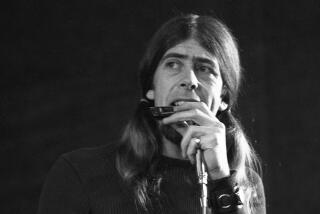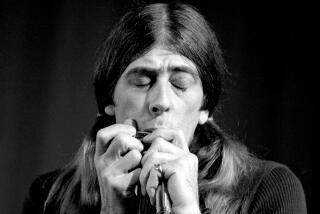Mayall Finds His Place Again, in His Roots
SOLANA BEACH — If a man is known by the company he keeps, John Mayall is certainly worthy of a top spot on rock music’s honor roll.
John Mayall’s Bluesbreakers, the seminal British blues band of the 1960s, was something of a training ground for a bevy of future rock ‘n’ roll heavy hitters.
Mayall, who will appear Thursday night at the Belly Up Tavern in Solana Beach, discovered, put to work, and taught a thing or two to such future stars as Eric Clapton, Jack Bruce, Mick Taylor (later of the Rolling Stones) and Mick Fleetwood and Peter Green (who went on to form Fleetwood Mac).
But, unlike so many of rock music’s most influential figures, Mayall has never been content to rest on his laurels.
After his early blues success, Mayall put the Bluesbreakers name to rest and shifted gears from blues to progressive jazz. Throughout the 1970s, he cut a series of solo albums that met with so-so reviews and were virtually ignored by the record-buying public.
In 1984, Mayall reformed the Bluesbreakers and returned to his blues roots. Since then, the veteran band leader and multi-instrumentalist has been enjoying both an artistic and a commercial renaissance.
Mayall’s latest album, “A Sense of Place,” which was released last spring by Island Records, not only got a great rap from critics, but made it onto Billboard’s Top Pop Albums chart. It’s his first chart album in 20 years, since 1970’s “USA Union,” which he recorded shortly after he moved from England to Los Angeles.
“Good reviews are always gratifying, but when they’re coupled with success in terms of sales, it’s doubly rewarding,” Mayall said. “It has, indeed, been a long time, and this is really a great thing to have happen.”
Mayall, who last week celebrated his 57th birthday, said he attributes his recent resurgence in popularity to good timing, more than anything else. He went back to playing the blues around the same time the public began rediscovering the blues.
“It’s a whole new audience out there, you have to remember that, and to them, this is something new,” Mayall said. “I think it really comes in cycles; as people grow up, they discover the blues at a certain point in their lives, and what seems to be happening now is that more and more people are getting to that point.”
Mayall was born in Manchester, England and discovered the blues as a child, listening to his father’s record collection.
“When I was about 3, I got addicted to the early 1930s recordings of the Mills Brothers, who imitated the jazz and blues sound with their voices,” Mayall recalled. “And it all grew from there. My father was a musician as a hobby, and he had a fairly large collection of 78s, many of them black American music.”
In 1955, after his discharge from the British army, Mayall formed his first band, the Powerhouse Four, just as something to do at night, after coming home from school and, later, from his day job as a typographer and graphic artist.
It wasn’t until 1963, when he was 30, that Mayall turned professional. He hit the London club scene with the Blues Syndicate, which a year later had evolved into John Mayall’s Bluesbreakers.
“When I started playing, it was strictly for my own satisfaction,” Mayall recalled. “I found nobody else was at all interested in it, so it was a very private thing, really, and that would account for why I didn’t think about music as a profession until I was 30.”
In the early 1960s, the London blues scene was just starting to develop, and Mayall quickly became one of its chief catalysts, discovering young players and turning them on to the blues. “In a way, it was the south’s answer to the north, to the Liverpool pop-rock thing dominated by the Beatles,” he said.
Night after night, Mayall and his compatriots would jam away in clubs, never realizing the future significance of what they were doing.
“It was a real underground thing,” he recalled. “No one had a record contract, and it was no big deal to anyone who didn’t come to the clubs, who wasn’t part of that scene. And, when you’re involved in it as a musician, you don’t look at the overall pattern. You make sure you’ve got a band and enough work to pay the wages; you’re more concerned about the day-to-day level than on how people might look on it in the future.”
By the end of 1964, the Bluesbreakers had signed with London Records and cut their first album, “John Mayall Plays John Mayall,” followed, a year later, with “Bluesbreakers--John Mayall With Eric Clapton.”
They graduated from the London club scene and began touring England, Europe and the United States, where Mayall, much to his delight, frequently found himself sharing the stage with some of his American blues idols.
“I was always awe-struck by playing with my idols,” he said, referring to such luminaries as T-Bone Walker and John Lee Hooker.
By the end of the decade, the Bluesbreakers had broken up, and Mayall had begun dabbling in jazz.
“I felt that, by the end of 1968, I had explored all the avenues I felt were possible in the blues, and I just wanted to try new things,” he said. “It started with ‘The Turning Point,’ my drummer-less album (that came out in 1970); that led me to wanting to work with some of my jazz heroes, to having musical affiliations with my favorite jazz artists and putting them into a blues setting.”
But, by the middle of the decade, his star had faded, culminating with the loss of his American recording contract when his U.S. label, ABC Records, folded in 1978.
“ABC went bankrupt, and there was no particular interest from any other record company,” Mayall recalled. “That’s why there was a gap in my recording career, from 1978 until 1986, two years after I decided to reform the Bluesbreakers and get back to my original blues sound.”
The Bluesbreakers reformation had been sparked by a one-shot reunion tour Mayall, Mick Taylor and John McVie had undertaken, on a lark, in early 1982. Buoyed by the enthusiastic public reaction, Mayall decided to give the Bluesbreakers a new lease on life.
The Los Angeles musicians he hired, he said, were handpicked and carefully groomed, just like their British predecessors had been some two decades earlier.
Since then, John Mayall’s Bluesbreakers, Model 2, have been touring regularly, averaging 120 dates a year. “There would be more, but I put a ceiling on it,” Mayall said. “Otherwise, I wouldn’t get any home life, and that’s very important to me.”
Through the ups and downs of his career, Mayall said, he’s learned to “never take anything for granted.” Still, he said, he can’t help but be optimistic about his future.
“The blues is such an everlasting form of inspiration to me; it’s quite inexhaustible, really,” Mayall said. “I think I still have a lot to say, and when you get a chance, with a major record company, to do so, you want to make sure you do it right.”
More to Read
The biggest entertainment stories
Get our big stories about Hollywood, film, television, music, arts, culture and more right in your inbox as soon as they publish.
You may occasionally receive promotional content from the Los Angeles Times.










